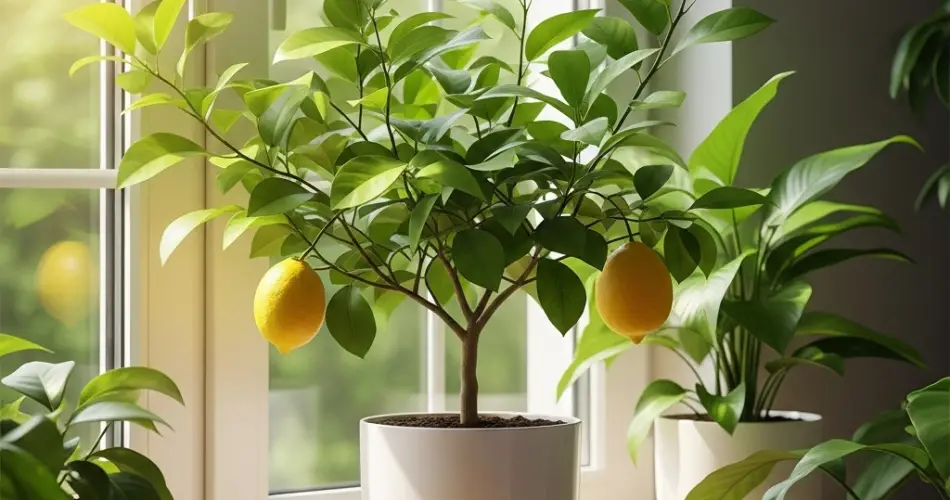Growing a lemon tree might sound like something only possible in a backyard orchard or a Mediterranean garden, but with the right setup, you can successfully grow a lemon tree right on your windowsill. These cheerful citrus trees not only produce fragrant blossoms and tangy fruit, but also brighten your space with lush, glossy green leaves. All it takes is a bit of care and consistency.
Whether you’re a beginner or an experienced gardener looking for a rewarding indoor project, here’s how to grow a healthy, fruit-producing lemon tree in a container—no garden required.
1. Choose the Right Variety
Not all lemon trees are suited for indoor life. When growing in containers, especially indoors, dwarf or semi-dwarf varieties are ideal. They’re compact, manageable, and still capable of producing full-sized lemons.
The best indoor lemon varieties include:
-
‘Improved Meyer’ Lemon – A popular choice for containers; sweet-tart flavor, smaller size, and nearly thornless.
-
‘Ponderosa’ Lemon – Produces large lemons and tolerates indoor conditions.
-
‘Lisbon’ or ‘Eureka’ – These standard lemon trees can also be grown in pots, but they need frequent pruning to stay manageable indoors.
Meyer lemon is often the top pick due to its adaptability and smaller stature.
2. Start with a Healthy Young Tree
While it’s possible to grow a lemon tree from seed, it’s much faster and more reliable to begin with a nursery-grown grafted tree. These trees are already established and will produce fruit within a couple of years—much sooner than seed-grown trees, which can take 5 to 10 years or more.
Choose a young, healthy plant with vibrant green leaves, strong stems, and no signs of pests or disease.
3. Select the Right Container
Lemon trees need room to grow, but not too much at once. Start with a container that’s at least 12–14 inches wide and deep, with multiple drainage holes.
As the tree matures, you’ll need to re-pot into a larger container every few years. Use containers made of plastic, ceramic, or clay—just ensure they’re durable and easy to move, as even small lemon trees can become heavy.
Place a saucer underneath to catch excess water if you’re growing the tree indoors.
4. Use Well-Draining, Slightly Acidic Soil
Lemon trees dislike soggy roots, so it’s essential to use a well-draining potting mix. Look for a mix labeled for citrus or cactus, or create your own using:
-
1 part potting soil
-
1 part perlite or coarse sand
-
1 part compost or organic matter
The soil should be slightly acidic (pH around 6.0 to 6.5), which helps the tree absorb nutrients efficiently.
5. Give It Plenty of Sunlight
Lemon trees are sun lovers. Indoors, they need 8–12 hours of bright, direct light daily. A south- or west-facing window is ideal.
If natural light is limited—especially in winter—use a full-spectrum grow light to supplement. Place the light 6–12 inches above the top of the tree and run it for 10–12 hours a day.
The more consistent the light, the healthier and more productive your lemon tree will be.
6. Water with Care
Lemon trees prefer consistent moisture, but not soggy soil.
-
Water when the top inch of soil feels dry.
-
Water deeply until it drains from the bottom, then let it dry slightly before watering again.
-
Reduce watering slightly in winter when growth slows.
Avoid letting the roots sit in standing water, which can lead to rot.
7. Boost Humidity Indoors
Indoor air—especially in heated homes during winter—can be very dry, and lemon trees prefer moderate humidity.
To raise humidity:
-
Mist the leaves occasionally.
-
Use a humidity tray (a shallow tray with pebbles and water).
-
Group your lemon tree with other plants to create a more humid microclimate.
8. Feed for Fruit
Lemon trees are heavy feeders. Use a citrus-specific fertilizer that’s rich in nitrogen and contains micronutrients like magnesium, zinc, and iron.
-
Feed every 4–6 weeks during the growing season (spring to early fall).
-
Reduce feeding in winter, when growth naturally slows.
Stick to the recommended dosage, and don’t over-fertilize—it can harm the tree more than help.
9. Encourage Pollination Indoors
Outdoors, bees and insects take care of pollination. Indoors, you may need to help.
When your lemon tree blooms:
-
Use a small paintbrush or cotton swab to gently transfer pollen from one flower to another.
-
Do this every day or two while flowers are open to improve fruit set.
With patience and care, your indoor lemon tree can produce delicious fruit.
Final Thoughts
Growing a lemon tree in a container on your sunny windowsill is both satisfying and surprisingly simple. With the right variety, proper care, and a good dose of sunlight, you’ll enjoy fragrant blossoms and homegrown lemons in your own space—no backyard needed.
This cheerful little tree not only yields fruit, but also adds life and beauty to your home. Start small, stay consistent, and watch your lemon tree thrive.



